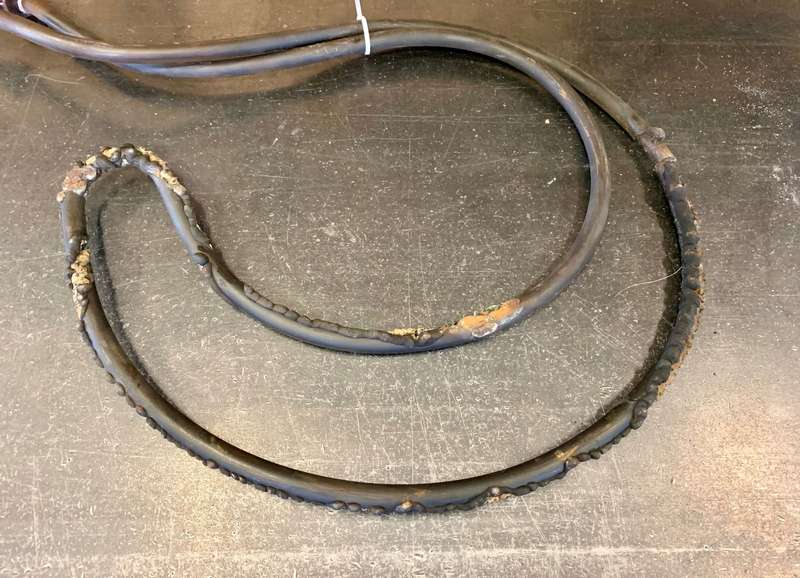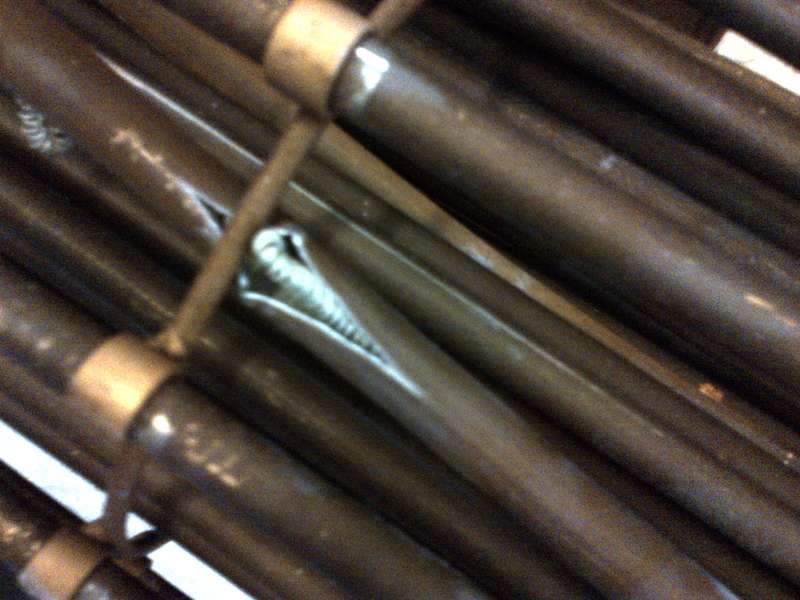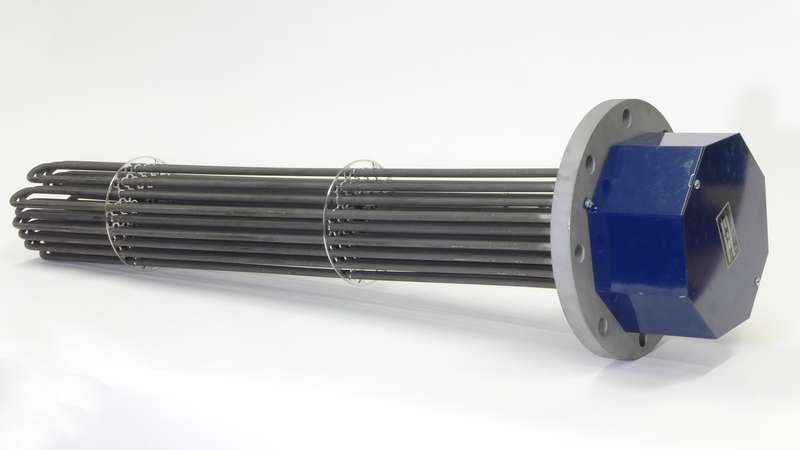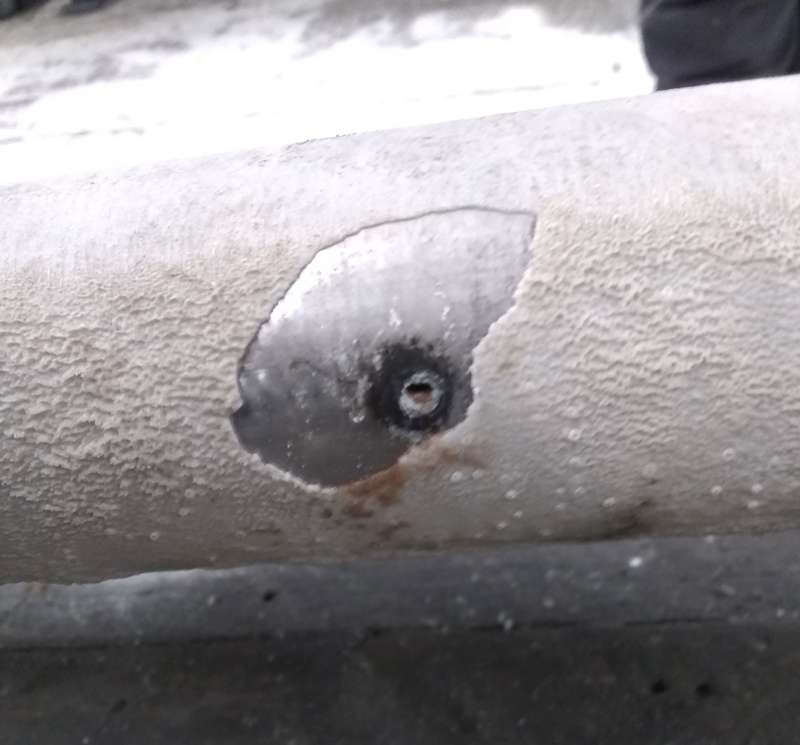Immersions heaters: Main causes of early breakage

There are others, obviously, or one cause can be paired with another among the list below, but in general, it most often comes down to the following!
Wattage per square inch too high for your application:
Max watts recommended:
Water: 60 watts/sq. inch
Air: 40 watts/sq. inch
Caustic or alkaline solution: 20-25 watts max/sq. inch*
*As the sheath rises in temperature, the more the chemical begins to attack it. So, for water containing a caustic or alkaline solution, even at low %, it is better to lower the watts/sq. inch.
Glycol: 40 watts/sq. inch
Motor oil: 25 watts/sq. inch
Vegetable oil: 40 watts/sq. inch
Hydraulic oil: 12 watts/sq. inch
Heating oil: 8 watts à 12 watts/sq. inch
Tip : It’s always better to have fewer watts per square inch than max watts, in order to extend the life of your elements. Contact us to find out the recommended wattage based on the number of liters of liquid in your tank.
| Formula for calculating watts/square inch: |
| Diameter x 3.1416 X Heating length = Watts/square inch |
| Ex: Your tubular has .315’’ diameter x 53’’ sheath length (48’’ heating), 1500W. |
| .315’’ dia. x 3.1416 = .98 x 48’’ heating = 47.5 watts/square inch |
| Conversely, if you take the same tubular and want to have 25 watts/square inch, you do: |
| .315’’ dia. x 3.1416 = .98 x 48 x 25 watts = 1176 watts total |
You don’t have the right sheath for your application:
The sheath is the tube of the heating element. Here are the most used sheath choices and the application associated with them:
Incoloy 840: For the open air. Unless there are corrosive fumes in your environment. In the latter case, we go with Incoloy 800.
Incoloy 800: Contains more nickel to prevent corrosion (only difference with Incoloy 840). Used for industrial process water: Soapy water, parts washer or when corrosive products are used. Also good for slightly caustic or alkaline solutions, or for sterilization of equipment. Used with vegetable oil as well.
Copper: For hot water tanks and kettles in hospitals, everything institutional and for large apartment buildings. IMPORTANT: There must be only water in the solution, no cleaning agents. Good choice if your liquid is glycol.
Stainless steel 316 or 304: For the whole food sector, for demineralized water (reverse osmosis), water from a well, for edible oil. The elements undergo a passivation treatment for the first three applications mentioned above in order to remove all residues that could rust.
Steel : For hydraulic oil, engine oil; or oils that facilitate heat transfer.
Your immersion heater ran out of water:
The sheath will blacken, color, and even cook. So, it has overheated.

When moisture gets involved!
Unfortunately, when moisture enters a heating element, it doesn’t come out easily. Let’s take the example of a water tank in a school. When the elements are fed again after having “bathed” in water all summer, it produces steam in the tubulars so it inflates the elements and they split open under pressure, unless there is a ground fault system to detect it. As it opens, the coil comes out of the tubular and so does the MgO powder.

The killer question: Why does the immersion heater in a residential water heater last longer than that in another application?
The household water heater gets solicited every day. Copper elements are used, since the only liquid in it is water. It is normal, as we’ve just seen, that an immersion heater that doesn’t heat up over a long time period lasts less. However, the same goes for an immersion heater that works 24 hrs/day!
Moderation is always in good taste!
Let’s not forget that a household immersion heater has fewer watts per square inch than a process immersion heater.
In addition, there is often something other than water in the tank of companies in the industrial field. So, it is a false belief to think that a copper sheath can last longer than an incoloy sheath. An incoloy sheath is more suitable for water containing another solution in its basin, even if the % is low.
When limescale makes our life harder!
Unfortunately, you can’t escape it, no matter how pure the city water.
True or false: Some cities are predisposed to limescale build-up around your elements.
True! Some cities have higher mineral content in their water, which causes limescale to develop more around the elements. Where! It is a secret we’ll never share! ;-)
Also, if your immersion heater works 24/7, this is the other predisposition that will encourage limescale to form around your elements.
You can clearly see the limestone deposit on the top tubes. There was so much limestone on the tubulars that they ended up burning it, as can be seen on the bottom tubes.
So, you have every advantage to ask for a moderate wattage, because the more a crust forms around the elements, the less they will last. The limescale crust comes to act as a shield. The tubular will heat the liquid less and less, causing the heated limescale to solidify, thus overheating the element and speeding up breakage.
The good or the bad news first?!
Good news: If you operate in an open circuit, limescale accumulates less on your elements, as it circulates with water.
Bad news: If you operate in a closed circuit, more limescale accumulates. This example is particularly striking at the dry cleaner shop. The steam evaporates so the water necessarily contains more minerals in a smaller amount of water. So you need an incoloy sheath in order to use a cleaning agent.
What are the Maestro solutions?
- Introduce a chemical cleaning agent such as CLR to dissolve limescale at a certain frequency.
- Vinegar can also be used, provided that it does not remain in the water for a long time (make sure the water circulates).
- If you empty the tank from time to time, another solution is to take out the elements and brush them.
- Of course, you can combine point 1 or 2 with point 3 for better results! ;-)
- We recommend Pipe-insert Immersion Heaters (for viscous fluids application).
- For a new application to be heated, consider another alternative if necessary, i.e. Pipe heaters
If you have an electric kettle!

- Make sure you have cylindrical supports (keepers) around your elements when they are numerous on the flange and long. Since it boils, the elements vibrate and eventually touch, this repetition ends up drilling holes in the sheath. As soon as there is a hole, the MgO powder gradually comes out and the water begins to circulate inside the tubular, eventually exiting through the terminals.
- The other phenomenon that occurs when it boils, is that of air bubble. These create a mini collision on the sheath which weakens the elements in the long run; resulting in pin hole.
- Sometimes, too many chemicals are added to the kettle or the water is not sufficiently treated and contains too many sediments. As we are not in closed circuit, oxygen from outside the kettle mixes in and produces a chemical reaction that once again, is noticeable in the form of a pin hole.
- Finally, in an industrial electric kettle, chemicals are added at a certain frequency to prevent limescale from setting. Therefore, it is essential that the sheath of your elements is incoloy.

Pin hole
In short, choose a reasonable wattage and review the complete design of the immersion heater with one of our technical advisors!
If you notice water coming out through the connections:
a) This may be the result of a poorly made weld. It is therefore a manufacturing defect if it occurs soon after installation. The element can be replaced free of charge, if proof is made (depending on the manufacturer, of course). ;-)
b) If your solution is chemical, over time, the sheath will be prone to chip, water seeping into the elements and coming out through the connections; especially if they are silver brazed, among other things. For more acidic solutions, TIG, a more resistant weld is used on connections. The acid also eats away at copper or brass connections.
c) Very high water pressure (ex: 300 PSI). In this case, make sure the cap of the NPT thread is not empty inside. Most of the time, the cap, e.g. brass, is empty inside. It must be full, in order to absorb more pressure.
Ultimately, there can be several simultaneous reasons for an immersion heater’s service life to be shortened.
It is therefore essential to inform us what your solution is composed of. Also, if possible, send us the material safety data sheet (s) so we can determine the best design for you!
 Skip site navigation
Skip site navigation




















